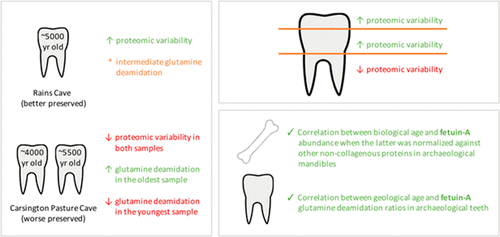当前位置:
X-MOL 学术
›
J. Proteome Res.
›
论文详情
Our official English website, www.x-mol.net, welcomes your
feedback! (Note: you will need to create a separate account there.)
Exploring Biological and Geological Age-related Changes through Variations in Intra- and Intertooth Proteomes of Ancient Dentine
Journal of Proteome Research ( IF 3.8 ) Pub Date : 2018-02-16 00:00:00 , DOI: 10.1021/acs.jproteome.7b00648 Noemi Procopio 1 , Andrew T. Chamberlain 2 , Michael Buckley 1
Journal of Proteome Research ( IF 3.8 ) Pub Date : 2018-02-16 00:00:00 , DOI: 10.1021/acs.jproteome.7b00648 Noemi Procopio 1 , Andrew T. Chamberlain 2 , Michael Buckley 1
Affiliation

|
Proteomic analyses are becoming more widely used in archeology not only due to the greater preservation of proteins in ancient specimens than DNA but also because they can offer different information, particularly relating to compositional preservation and potentially a means to estimate biological and geological age. However, it remains unclear to what extent different burial environments impact these aspects of proteome decay. Teeth have to date been much less studied than bone but are ideal to explore how proteins decay with time due to the negligible turnover that occurs in dentine relative to bone. We investigated the proteome variability and deamidation levels of different sections of molar teeth from archeological bovine mandibles as well as their mandibular bone. We obtained a greater yield of proteins from the crown of the teeth but did not find differences between the different molars analyzed within each mandible. We also obtained the best variety of protein from a well-preserved mandible that was not the youngest one in terms of chronological age, showing the influence of the preservation conditions on the final proteomic outcome. Intriguingly, we also noticed an increase in abundance levels of fetuin-A in biologically younger mandibles as reported previously, but the opposite trend in tooth dentine. Interestingly, we observed higher glutamine deamidation levels in teeth from the geologically oldest mandible despite it being the biologically youngest specimen, showing that the archeological age strongly impacts on the level of deamidations observed, much more so than biological aging. This indicates that the glutamine deamidation ratio of selected peptides may act as a good predictor of the relative geochronological age of archeological specimens.
中文翻译:

通过古代牙质的齿内和齿间蛋白质组变异探索与生物和地质年龄相关的变化
蛋白质组学分析在考古学中的应用越来越广泛,这不仅是因为古代标本中的蛋白质比DNA具有更好的保存性,而且还因为它们可以提供不同的信息,尤其是与成分保存有关的信息以及潜在的估计生物学和地质年龄的手段。但是,尚不清楚不同的埋葬环境在多大程度上影响蛋白质组学的这些方面。迄今为止,牙齿的研究还远远少于骨骼,但是,由于牙本质相对于骨骼的周转率可忽略不计,因此探索蛋白质如何随时间衰减是理想的选择。我们从考古学的牛下颌骨及其下颌骨调查了臼齿不同部分的蛋白质组变异性和脱酰胺水平。我们从牙齿的冠部获得了更高的蛋白质产量,但没有发现每个下颌骨中分析的不同臼齿之间的差异。我们还从保存完好的下颌骨中获得了最好的蛋白质品种,这在时间顺序上并不是最年轻的下颌骨,显示出保存条件对最终蛋白质组学结果的影响。有趣的是,我们还注意到,生物学上较年轻的下颌骨中胎球蛋白A的丰度水平有所增加,如先前报道的,但牙本质却呈现出相反的趋势。有趣的是,尽管生物学上最年轻的标本,但我们观察到地质上最老的下颌骨牙齿中的谷氨酰胺脱酰胺水平更高,这表明考古学年龄对所观察到的脱酰胺水平有很大影响,远比生物衰老更严重。
更新日期:2018-02-17
中文翻译:

通过古代牙质的齿内和齿间蛋白质组变异探索与生物和地质年龄相关的变化
蛋白质组学分析在考古学中的应用越来越广泛,这不仅是因为古代标本中的蛋白质比DNA具有更好的保存性,而且还因为它们可以提供不同的信息,尤其是与成分保存有关的信息以及潜在的估计生物学和地质年龄的手段。但是,尚不清楚不同的埋葬环境在多大程度上影响蛋白质组学的这些方面。迄今为止,牙齿的研究还远远少于骨骼,但是,由于牙本质相对于骨骼的周转率可忽略不计,因此探索蛋白质如何随时间衰减是理想的选择。我们从考古学的牛下颌骨及其下颌骨调查了臼齿不同部分的蛋白质组变异性和脱酰胺水平。我们从牙齿的冠部获得了更高的蛋白质产量,但没有发现每个下颌骨中分析的不同臼齿之间的差异。我们还从保存完好的下颌骨中获得了最好的蛋白质品种,这在时间顺序上并不是最年轻的下颌骨,显示出保存条件对最终蛋白质组学结果的影响。有趣的是,我们还注意到,生物学上较年轻的下颌骨中胎球蛋白A的丰度水平有所增加,如先前报道的,但牙本质却呈现出相反的趋势。有趣的是,尽管生物学上最年轻的标本,但我们观察到地质上最老的下颌骨牙齿中的谷氨酰胺脱酰胺水平更高,这表明考古学年龄对所观察到的脱酰胺水平有很大影响,远比生物衰老更严重。











































 京公网安备 11010802027423号
京公网安备 11010802027423号